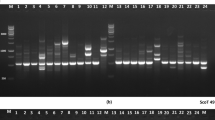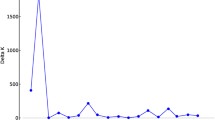Abstract
The world’s oldest and largest Medicago truncatula collection is housed at the South Australian Research and Development Institute (SARDI). We used six simple sequence repeat (SSR) loci to analyse the genetic diversity and relationships between randomly selected individuals from 192 accessions in the core collection. M. truncatula is composed of three subspecies (ssp.): ssp. truncatula, ssp. longeaculeata, and ssp. tricycla. Analysis at the level of six SSR loci supports the concept of ssp. tricycla, all the samples of which showed unique alleles at two loci. Contingency Chi-squared tests were significant between ssp. tricycla and ssp. truncatula at four loci, suggesting a barrier to gene flow between these subspecies. In accessions defined as ssp. longeaculeata, no unique allelic distribution or diagnostic sizes were observed, suggesting this apparent ssp. is a morphological variant of ssp. truncatula. The data also suggest M. truncatula that exhibits unusually wide genotype dispersal throughout its native Mediterranean region, possibly due to animal and trade-related movements. Our results showed the collection to be highly diverse, exhibiting an average of 25 SSR alleles per locus, with over 90% of individuals showing discrete genotypes. The rich diversity of the SARDI collection provides an invaluable resource for studying natural allelic variation of M. truncatula. To efficiently exploit the variation in the SARDI collection, we have defined a subset of accessions (n=61) that maximises the diversity.

Similar content being viewed by others
References
Agapow P-M, Burt A (2000) MultiLocus v1.2.2. Imperial College, London
Baquerizo-Audiot E, Desplanque B, Prosperi J, Santoni S (2001) Characterization of microsatellite loci in the diploid legume Medicago truncatula (barrel medic). Mol Ecol Notes:1–3
Bataillon TM, David JL, Schoen DJ (1996) Neutral genetic markers and conservation genetics: simulated germplasm collections. Genetics 144:409–417
Bevan J, Crute I, Clarke D (1993a) Diversity and variation in expression of resistance to Erysiphe fischeri in Senecio vulgaris. Plant Pathol 42:647–653
Bevan J, Crute I, Clarke D (1993b) Resistance to Erysiphe fischeri in two populations of Senecio vulgaris. Plant Pathol 42:636–646
Bonnin I, Ronfort J, Wozniak F, Olivieri I (2001) Spatial effects and rare outcrossing events in Medicago truncatula (Fabaceae). Mol Ecol 10:1371–1383
Brown AHD (1989a) The case for core collections. In: Brown AHD, Frankel OH, Marshall DR, Williams JT (eds) The use of plant genetic resources. Cambridge University Press, Cambridge, pp 136–156
Brown AHD (1989b) Core collections: a practical approach to genetic resources management. Genome 31:818–824
Choi H-K, Kim D, Uhm T, Limpens E, Lim H, Mun J-H, Kalo P, Penmetsa RV, Seres A, Kulikova O, Roe BA, Bisseling T, Kiss GB, Cook DR (2004) A sequence-based genetic map of Medicago truncatula and comparison of marker colinearity with M. sativa. Genetics 166:1463–1502
Crawford EJ, Lake AWH, Boyce KG (1989) Breeding annual Medicago species for semi-arid conditions in southern Australia. Adv Agron 42:399–437
Doyle J (2001) Leguminosae. In: Brenner SMJ (ed) Encyclopaedia of genetics. Academic, San Diego, pp 1081–1085
Eujayl I, Sledge M, Wang L, May G, Chekhovskiy K, Zwonitzer J, Mian M (2004) Medicago truncatula EST-SSRs reveal cross-species genetic markers for Medicago spp. Theor Appl Genet 108:414–422
Goldstein D, Linares A, Cavalli-Sforza L, Feldman M (1995) Genetic absolute dating based on microsatellites and the origin of modern humans. Proc Natl Acad Sci USA 92:6723–6727
Gouesnard B, Bataillon TM, Decoux G, Rozale C, Schoen DJ, David JL (2001) MSTRAT: an algorithm for building germ plasm core collections by maximizing allelic or phenotypic richness. J Hered 92:93–94
Gupta P, Rustgi S, Sharma S, Singh R, Kumar N, Balyan H (2003) Transferable EST-SSR markers for the study of polymorphism and genetic diversity in bread wheat. Mol Genet Genomics 270:315–323
Gustafsson S, Lonn M (2003) Genetic differentiation and habitat preference of flowering-time variants within Gymnadenia conopsea. Heredity 91:284–292
Hammerli A, Reusch T (2003) Genetic neighbourhood of clone structures in eelgrass meadows quantified by spatial autocorrelation of microsatellite markers. Heredity 91:448–455
Hayden M, Stephenson P, Logojan A, Khatkar D, Rogers C, Koebner R, Snape J, Sharp P (2004) A new approach to extending the wheat marker pool by anchored PCR amplification of compound SSRs. Theor Appl Genet 108:733–742
Heyn C (1963) The annual species of Medicago. Scripta Hierosolymitana 12:1–154
Kumar S, Tamura K, Jakobsen IB, Nei M (2001) MEGA2: molecular evolutionary genetics analysis software. Bioinformatics 17:1244–1245
Lunney HWM (1983) Vegetable fault in Australian wool: Classification, consequences, and economic loss. J Aust Inst Agric Sci 49:207–211
McKhann HI, Camilleri C, Berard A, Bataillon T, David JL, Reboud X, Le Corre V, Caloustian C, Gut IG, Brunel D (2004) Nested core collections maximizing genetic diversity in Arabidopsis thaliana. Plant J 38:193–202
Minch E, Ruiz-Linares A, Goldstein D (1995) Microsat 1.4, a computer program for the calculation of genetic distance from microsatellite data. Stanford University Medical Centre, Stanford
Nei M (1973) Analysis of gene diversity in subdivided populations. Proc Natl Acad Sci USA 70:3321–3323
Nei M (1987) Molecular evolutionary genetics. Columbia University Press, New York
Peakall R, Gilmore S, Keys W, Morgante M, Rafalski A (1998) Cross-species amplification of soybean (Glycine max) simple sequence repeats (SSRs) within the genus and other legume genera: implications for the transferability of SSRs in plants. Mol Biol Evol 15:1275–1287
Pearson CJ, Brown R, Collins WJ, Archer KA, Wood MS, Petersen C, Bootle B (1997) An Australian temperate pastures database. Aust J Agric Res 48:453–466
Raymond M, Rousset F (1995) Genepop version 1.2: population genetics software for exact tests and ecumenicism. J Hered 86:248–249
Saha MC, Mian MAR, Eujayl I, Zwonitzer JC, Wang L, May GD (2004) Tall fescue EST-SSR markers with transferability across several grass species. Theor Appl Genet 109:783–791
Schoen D, Brown A (1993) Conservation of allelic richness in wild crop relatives is aided by assessment of genetic markers. Proc Natl Acad Sci USA 90:10623–10627
Skinner D, Bauchan G, Auricht G, Hughes S (1999) A method for the efficient management and utilization of large germplasm collections. Crop Sci 39:1237–1242
Small E, Jomphe M (1989) A synopsis of the genus Medicago (Leguminosae). Can J Bot 67:3260–3294
Thiel T, Michalek W, Varshney R, Graner A (2003) Exploiting EST databases for the development and characterization of gene-derived SSR-markers in barley (Hordeum vulgare L.). Theor Appl Genet 106:411–422
Thoquet P, Ghérardi M, Journet E, Kereszt A, Ané J, Prosperi J, Huguet T (2002) The molecular genetic linkage map of the model legume Medicago truncatula: an essential tool for comparative legume genomics and the isolation of agronomically important genes. BMC Plant Biol 2
Workman P, Niswander J (1970) Population studies on southwestern Indian tribes. II. Local genetic differentiation in the Papago. Am J Hum Genet 22:24–49
Yan H, Mudge J, Kim D, Shoemaker R, Cook D, Young N (2004) Comparative physical mapping reveals features of microsynteny between Glycine max, Medicago truncatula, and Arabidopsis thaliana. Genome 47:141–55
Yeh F, Yang R, Boyle T (1999) POPGENE version 1.31. Microsoft Windows-based software for population genetics analysis. University of Alberta and Centre for International Forestry Research, Alberta
Young N, Mudge J, Ellis T (2003) Legume genomes: more than peas in a pod. Curr Opin Plant Biol 6:199–204
Yu J-K, La Rota M, Kantety RV, Sorrells ME (2004) EST derived SSR markers for comparative mapping in wheat and rice. Mol Genet Genomics 271:742–751
Acknowledgements
This research was funded by the Grains Research and Development Corporation of Australia (GRDC), and the Department of Education, Science and Training (DEST). We would like to thank Steve Hughes, the curator of Australian Medicago Genetic Resources Centre, for providing seed. The research was conducted at the State Agricultural Biotechnology Centre, Murdoch University, Western Australia.
Author information
Authors and Affiliations
Corresponding author
Additional information
Communicated by F. J. Muehlbauer
Rights and permissions
About this article
Cite this article
Ellwood, S., D’Souza, N., Kamphuis, L. et al. SSR analysis of the Medicago truncatula SARDI core collection reveals substantial diversity and unusual genotype dispersal throughout the Mediterranean basin. Theor Appl Genet 112, 977–983 (2006). https://doi.org/10.1007/s00122-005-0202-1
Received:
Accepted:
Published:
Issue Date:
DOI: https://doi.org/10.1007/s00122-005-0202-1




